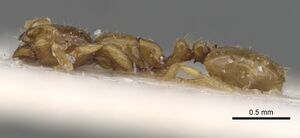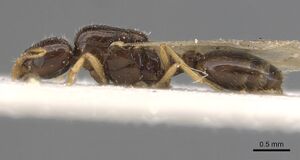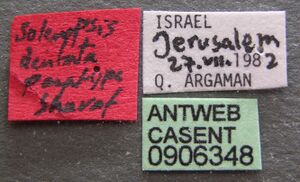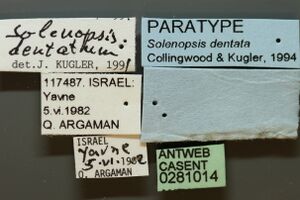Solenopsis dentata
| Solenopsis dentata | |
|---|---|

| |
| Scientific classification | |
| Kingdom: | Animalia |
| Phylum: | Arthropoda |
| Class: | Insecta |
| Order: | Hymenoptera |
| Family: | Formicidae |
| Subfamily: | Myrmicinae |
| Tribe: | Solenopsidini |
| Genus: | Solenopsis |
| Species: | S. dentata |
| Binomial name | |
| Solenopsis dentata Collingwood & Kugler, J., 1994 | |
Nothing is known about the biology of Solenopsis dentata.
Identification
Collingwood and Kugler (1994) - S. dentata is easily distinguished from most other species of Solenopsis by the anteroventral toothlike projection of the postpetiole in lateral view. This projection is readily observable in all castes. A similar structure was recorded and figured by Emery (1909) for a female of Solenopsis from Tunisia doubtfully belonging to Solenopsis orbula var. terniensis. S. orbula, including var. terniensis, however, is characterized by a much longer head in the worker and female than in S. dentata.
Workers of an undescribed Solenopsis species, collected in Oman, also have the ridge and the tooth-like projections on the postpetiole but they possess a more abundant and longer pilosity than the Mediterranean S. dentata.
Distribution
Latitudinal Distribution Pattern
Latitudinal Range: 32.983333° to 30.983333°.
| North Temperate |
North Subtropical |
Tropical | South Subtropical |
South Temperate |
- Source: AntMaps
Distribution based on Regional Taxon Lists
Palaearctic Region: Israel (type locality).
Distribution based on AntMaps
Distribution based on AntWeb specimens
Check data from AntWeb
Countries Occupied
| Number of countries occupied by this species based on AntWiki Regional Taxon Lists. In general, fewer countries occupied indicates a narrower range, while more countries indicates a more widespread species. |

|
Estimated Abundance
| Relative abundance based on number of AntMaps records per species (this species within the purple bar). Fewer records (to the left) indicates a less abundant/encountered species while more records (to the right) indicates more abundant/encountered species. |

|
Biology
Castes
Worker
Images from AntWeb
   
| |
| Paratype of Solenopsis dentata. Worker. Specimen code casent0281034. Photographer Shannon Hartman, uploaded by California Academy of Sciences. | Owned by CAS, San Francisco, CA, USA. |
   
| |
| Worker. Specimen code casent0906349. Photographer Estella Ortega, uploaded by California Academy of Sciences. | Owned by KSMA; KSU, King Saud University Museum of Arthropods. |
Queen
Images from AntWeb
    
| |
| Paratype of Solenopsis dentata. Queen (alate/dealate). Specimen code casent0281015. Photographer Shannon Hartman, uploaded by California Academy of Sciences. | Owned by CAS, San Francisco, CA, USA. |
    
| |
| Queen (alate/dealate). Specimen code casent0906348. Photographer Estella Ortega, uploaded by California Academy of Sciences. | Owned by KSMA; KSU, King Saud University Museum of Arthropods. |
Male
Images from AntWeb
    
| |
| Paratype of Solenopsis dentata. Male (alate). Specimen code casent0281014. Photographer Shannon Hartman, uploaded by California Academy of Sciences. | Owned by CAS, San Francisco, CA, USA. |
Nomenclature
The following information is derived from Barry Bolton's Online Catalogue of the Ants of the World.
- dentata. Solenopsis dentata Collingwood & Kugler, J. 1994: 120, figs. 1-9 (w.q.m.) ISRAEL.
- Type-material: holotype worker, 28 paratype workers, 3 paratype queens, 2 paratype males.
- Type-locality: holotype Israel: Yavne (Southern Coastal Plain), 5.vi.1982 (Q. Argaman); paratypes: 7 workers, 1 male with same data, 3 workers, 2 queens Israel: Jerusalem, 27.vii.1982 (Q. Argaman), 1 queen, 1 male Tel Aviv, 20.vi.1978 (J. Kugler), 8 workers Qiryat Anavim, 8.iv.1940 (H. Bytinski-Salz), 3 workers Yeroham, 23.iii.1960 (J. Kugler), 4 workers Meron (Upper Galilee), 21.iv.1984 (C.A. Collingwood), 3 workers Zekharya, 17.iv.1984 (C.A. Collingwood).
- Type-depositories: TAUI (holotype); TAUI, WMLC (paratypes).
- Status as species: Vonshak, et al. 2009: 44; Borowiec, L. 2014: 153.
- Distribution: Israel.
Unless otherwise noted the text for the remainder of this section is reported from the publication that includes the original description.
Description

Worker
TL 1.72-2.33, HL 0.48-0.65, HW 0.40-0.58, CI 82.2-89.2, SL 0.33-0.46, SI 80.7-89.2 (10 measured).
Color yellow. Head (Fig. 2) with widely scattered punctures and a few scratch marks on the lower genae, the rest of the head and the body shining without distinct sculpture. All parts of the body with scattered fine long hairs. Head not much longer than broad, with lateral margin slightly curved; occiput with rounded comers. Eye small, with 7 ommatidia set laterally well below midline of head. Anterior clypeal margin with central pair of stout projecting teeth, 0.07 mm long, and a lateral pair of short, broad basal blunt teeth. Alitrunk (Fig. 1) with small but acute mesopropodeal furrow. Petiole in lateral view (Fig. 5) with high, rounded node, anterior peduncle with distinct small ventral tooth; in dorsal view (Fig. 6) petiolar node twice as wide as long. Postpetiole lower, more or less cubical, in lateral view with distinct anteroventral toothlike process which bears few long hairs (Fig. 5). This process is one of two projections of transverse ridge (Fig. 7).
Queen
TL 3.57-3.92, HL 0.72-0.76, HW 0.67-0.72, CI 93-94.7, SL 0.45-0.50, SI 67.16-69.4 (4 measured).
Body brilliant brownish black, with occasional punctures; antenna, mandible and legs yellow.
Head (Fig. 3) slightly longer than broad; eye oval with 18 ommatidia in the longest row; ocelli circular, anterior slightly larger than posterior ones, clypeal tooth and petiole as in worker; postpetiole as in worker with toothlike processes bearing hairs (Fig. 8).
Male
TL 2.9-3.1, HL 0.46--0.48, HW 0.46--0.48, CI 100, SL 0.12--0.14, SI 26-29.1 (5 measured).
Body brilliant black brown, scapus and coxa dark brown, rest of leg, funiculus and mandible brownish yellow; hairs and wing veins yellow, pterostigma brown.
Head (Fig. 4) as long as wide; above the eyes smooth and shiny; margin of vertex between posterior ocelli straight, a little concave; lateral margin of head between upper margins of eye and posterior ocellus curved, longer than the large diameter of eye; anterior ocellus a little wider than high; posterior ocelli directed laterally, their upper margin protruding above head margin. In the 12 segmented antenna, scapus short, twice as long as wide. First funicular segment globular, a little wider than long, the following segments longer than wide, increasing in length, last segment 5 times as long as wide; mandible narrow with 2 or 3 teeth. Mesonotum smooth and shiny without remarkable sculpture, anteriorly with 2 fine furrows.
Petiole and postpetiole (Fig. 9) shiny, only partly reticulate, with scattered long hairs; in side view petiolar node angular, postpetiole ventrally with 2 toothlike projections, each bearing hairs.
Type Material
Holotype queen, Israel: Yavne [Southern Coastal Plain] 5.vi.1982 (Q. Argaman). Paratypes. Israel: Yavne, 5.iv.1982 (Q. Argaman) 1 male + 7 workers. Jerusalem (Judean Hills), 27.vii.1982 (Q. Argaman) 2 queens + 3 workers. Tel Aviv (Southern Coastal Plain), 20.vi.l978 (J. Kugler) 1 male + 1 queen. Qiryat Anavim (Judean Hills), 8.iv.1940 (H. Bytinski-Salz) 8 workers. Yeroham (Northern Negev), 23.iii.1960 (J. Kugler) 3 workers. Meron (Upper Galilee), 21.iv.1984 (under stone) (C.A. Collingwood) 4 workers. Zekharya (Foothills of Judea), 17.iv.l984 (C.A. Collingwood) 3 workers.
The holotype and most paratypes are deposited in the Zoological Museum of Tel Aviv University; some paratypes are preserved in the collection of C.A. Collingwood.
References
- Borowiec, L. 2014. Catalogue of ants of Europe, the Mediterranean Basin and adjacent regions (Hymenoptera: Formicidae). Genus (Wroclaw) 25(1-2): 1-340.
- Collingwood, C. A.; Kugler, J. 1994. Solenopsis dentata (Hymenoptera, Formicidae): a new species from Israel. Isr. J. Entomol. 28:119-122. (page 120, figs. 1-9 worker, queen, male described)
References based on Global Ant Biodiversity Informatics
- Borowiec L. 2014. Catalogue of ants of Europe, the Mediterranean Basin and adjacent regions (Hymenoptera: Formicidae). Genus (Wroclaw) 25(1-2): 1-340.
- Kugler, J. "A new species of Cataglyphis Förster (Hymenoptera: Formicidae) from Israel and Sinai." Israel Journal of Entomology 15 (1981): 83-88.
- Vonshak M., and A. Ionescu-Hirsch. 2009. A checklist of the ants of Israel (Hymenoptera: Formicidae). Israel Journal of Entomology 39: 33-55.

